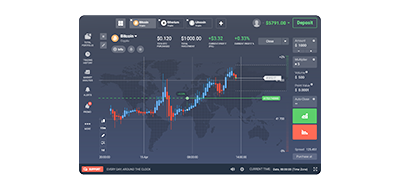Back
Contents
A Dive Into the Wheel Strategy


Vitaly Makarenko
Chief Commercial Officer

Iva Kalatozishvili
Business Development Manager
What is the Wheel Strategy?
The Wheel Strategy is an extremely powerful options trading strategy through which you can develop consistent income in a very semi-passive manner over the long term. Unlike most other option strategies dependent on directional bets or complex structures, a wheel strategy is more methodical and neutral in its approach. It’s designed to take advantage of whether the stock or market goes up, down, or sideways.
The essence of the Wheel Strategy consists of continuously selling cash-secured puts and covered calls on the same high-quality stocks or index funds. You can collect the premiums for selling options, pick up shares at a discount, capture dividends, and benefit from long-term appreciation in the stock. You also get to benefit from long-term stock appreciation while maintaining a defined risk profile.
The Mechanics of the Wheel Strategy
The Wheel Strategy is a two-part process that involves selling cash-secured put options and covered call options on the same underlying asset. Let’s break down each component in detail:

1. Selling Cash-Secured Put Options
By selling a put, you are obligated to buy the underlying security at the strike price when someone exercises the option. To do it right, you need to have enough capital in your brokerage account to purchase 100 shares of the underlying security at the strike price. It’s called a “cash-secured” put.
There are two possible outcomes when the put option expires:
- The stock price is above the strike price: In this case, the option expires worthless, and you get to keep the full premium you collected when selling the put. You can then look to sell another put option on the same or a different underlying asset.
- The stock price is below the strike price: If the option is exercised, you’ll be required to purchase 100 shares of the underlying asset at the strike price. However, the premium you collected when selling the put will help offset the cost basis of the shares you’re acquiring.
2. Selling Covered Call Options
Once you’ve been assigned the underlying shares, the next step is to sell covered call options on those same shares. A covered call is an options strategy where you own the underlying asset and sell call options against it.
There are two possible outcomes when the covered call option expires:
- The stock price is below the call strike price: In this case, the call option expires worthless, and you get to keep the full premium you collected. You can then look to sell another covered call option on the same shares.
- The stock price is above the call strike price: If the option is exercised, you’ll be required to sell 100 shares of the underlying asset at the strike price. While this means you’ll have to part with your shares, you’ll still get to keep the premium you collected when selling the covered call.
3. The Full Wheel Strategy Cycle
The full-wheel strategy involves cycling between selling cash-secured puts and covered calls on the same underlying asset. With a repetitive cycle of selling, you get to constantly receive option premiums, be in a position to buy shares at a discount, capture dividend income, and long-term stock appreciation.
How to Select Stock and Assets for the Wheel Strategy
Success with the Wheel Strategy largely revolves around selecting the underlying assets in which one wants to trade. While the mechanics of the strategy itself is rather simple, there can be a lot of variance in overall return and risk profile depending on the specific stocks, ETFs, or indices chosen for trading.
1. Identifying High-Quality, Fundamentally Sound Stocks
Regarding individual stocks, you want to pay attention to firms with strong financials, some sort of competitive advantage, and at least a long-term growth prospect. Certain key attributes to look out for include:
- Consistent profitability and cash flow generation
- Healthy balance sheets with manageable debt levels
- Dominant market positions or unique product/service offerings
- Proven track records of growth and shareholder-friendly management
- Attractive valuation metrics (e.g., price-to-earnings, price-to-book)
By selecting high-quality stocks, you’re reducing the risk of significant price declines that could lead to unfavourable assignments or difficulty selling covered calls. This helps ensure the long-term viability of your Wheel Strategy positions.
2. Leveraging Index Funds and ETFs
When you identify index-based assets for use in your Wheel Strategy, choose those that best fit your overall investment objectives and risk tolerance. You might want to consider multiple indices or sectors to further optimize the risk/reward profile of your options trading activity. Some popular choices include:
- S&P 500 Index (SPY, VOO, IVV)
- Nasdaq-100 Index (QQQ)
- Dow Jones Industrial Average (DIA)
- Total U.S. Stock Market (VTI, SCHB)
- Sector-specific ETFs (e.g., XLF, XLK, XLV)
3. Diversification and Position Sizing
Appropriate diversification and position sizing are very crucial, whether trading single stocks or index-based products, with respect to a Wheel Strategy portfolio. One should avoid concentrating too much capital on any one underlying asset. This may lead to some outsized risks that one may not want to take.
As a general rule of thumb, no single-wheel strategy position should be more than 5-10% of your overall investable capital. This gives you a pretty good idea of how much overall risk you are taking on, and how to make sure that no one poor outcome has too large a consequence to your portfolio. You may also seek to further diversify your Wheel Strategy holdings as a means of evening out their returns for more consistent performance over time.
You may also like

How to Maximize Returns with the Wheel Strategy
1. Optimizing Option Parameters
The choice of strike price and expiration date will have a great deal to do with the premiums that you get back and the risk/reward profile for your trade. For selling put options, you will most often want to look for strike prices a little beneath the current market price of the underlying asset. As for covered calls, the option seller will be looking for strike prices a little above the current market price.
2. Capturing Dividends and Dividend Growth
This way, during the covered call phase of the cycle, when holding such assets, any dividend paid by the companies or funds can be collected. In addition to dividend-paying stocks, only look at those that have a history of consistent dividend growth and are able to achieve compounding in returns over time. Growing your income payments from your holdings of higher-paying dividends will allow the overall return in Wheel Strategy positions to grow.
3. Leveraging Volatility and Market Conditions
The Wheel Strategy may also be adapted to adjust for changing market conditions and levels of volatility. Where there is a higher impaired volatility (IV), you may be able to collect higher premiums when selling your puts and calls. You may want to adjust your strike prices and position sizes in low-volatility environments to maintain a favourable risk/reward profile.
4. Monitoring and Adjusting the Wheel Strategy
Finally, one should always be monitoring positions taken with the Wheel Strategy, prepared to undertake any necessary changes at any point in time. That means:
- Monitoring cost basis and profitability at all levels on every underlying asset;
- Periodically reassessing fundamental and technical conditions of your holdings;
- Looking for opportunities to roll the options contracts or close the positions at favourable prices;
- Rebalancing the portfolio in order to maintain adequate diversification and position sizes.
How to Implement the Wheel Strategy

1. Brokerage Account Setup and Margin Requirements
In order to appropriately implement the Wheel Strategy, you would have to maintain an online brokerage account through which you could deal in options. While most of the major online brokers provide such facilities, some may have different requirements regarding your account and margin rules.
This will necessitate you to have capital in your account to be able to purchase 100 shares of the underlying asset at the strike price when selling cash-secured puts. This is customarily tagged as the “cash-secured” requirement. In the case of covered calls, you have to possess shares in your account.
Depending on your brokerage firm and your options positions, you may be subject to a margin call to carry a certain amount of margin in your account. In that respect, it is a guarantee that you are able to meet any assignment or exercise of the said options contracts.
2. Order Execution and Management
To implement the Wheel Strategy, you will want to set or execute the following different order types, to name a few:
- Selling cash-secured put options
- Selling covered call options
- Possibly rolling options contracts forward
- Closing positions by assignment or call-away of shares
Most brokers will extend to you the facility to place such orders directly with them through their trading platforms either as an individual order or by using automated order tools and strategies. Let careful attention be paid to order type, time-in-force, and other parameters so that your trades are executed in a manner befitting your desires.
You are also going to have to develop an organized system through which you will be able to monitor your open positions, manage your options as they expire, and roll the contracts forward, when necessary. That way, you will be able to maintain tight control over your Wheel Strategy with no surprise results.
3. Record-keeping and Tax Implications
As with any investment strategy, it’s crucial to meticulously track your Wheel Strategy transactions and maintain detailed records. This includes documenting:
- The dates and prices of your options trades (puts and calls)
- The strike prices, expiration dates, and premiums collected
- The dates and prices of any stock purchases or sales
- Any dividend payments received
- Your overall cost basis and profitability for each underlying asset
Proper record-keeping will not only help you monitor the performance of your Wheel Strategy over time, but it will also be essential for accurately reporting your options trading activity on your tax returns.
The tax treatment of options trading can be complex, with different rules and reporting requirements for short-term versus long-term positions, as well as for gains and losses. Be sure to consult with a qualified tax professional to ensure you’re properly accounting for and reporting your Wheel Strategy activities.
Risks and Drawbacks of the Wheel Strategy
1. Potential Losses from Stock Price Declines
One of the greatest risks from the Wheel Strategy is the loss that may be incurred in the event of a high price decline in either the stock or the ETF. You will be required to purchase the shares at the strike price, should the put option you have sold get exercised, and this will be higher than the market value of the stocks. This will result in an immediate paper loss on the position.
You may also like

2. Opportunity Cost and Missed Upside from Assigned Calls
Another potential disadvantage with the Wheel Strategy is the opportunity cost and missed upside when your covered call options get exercised and your shares get called away. The premium that you have received will most certainly help to ease this situation, but you will still have to forego any further upside above the call strike price in the underlying asset.
3. Impact of Market Volatility and Unexpected Events
The Wheel Strategy is also susceptible to various market fluctuations and unexpected occurrences. Periods of high volatility are often characterized by broader spreads between the bidding and asking. This may involve less favourable option pricing, which could well impact the premiums you can receive. Among other things, it involves massive market surprises, including company news with negative repercussions in the form of unfavourable assignments and /or issues with options contracts rollovers.
4. Psychological Challenges and Discipline Required
The Wheel Strategy demands a very high level of discipline and emotional management from the trader. Successive repetitions with the selling of the put-call combination, position management, and periodic adjustment at the right time become quite exhausting in terms of mental and psychological strength. The demand for all these is not always easy to put into practice, especially when situations are turbulent and unpredictable.
Conclusion
The Wheel Strategy is a very robust and versatile framework for trading options in which one can realize fairly predictable, semi-passive income over the long run. Systematically sell cash-secured puts and covered calls on high-quality stocks or index funds; collect option premiums while potentially acquiring shares at a discount, capturing dividend income, and benefiting from the stock’s long-term appreciation.
FAQ
The Wheel Strategy refers to one well-defined approach of options trading: selling cash-secured put options and covered call options on high-quality stocks or index funds systematically. This would allow traders to capture regular, semi-passive income coming from option premiums, get shares at a discount, capture dividend income, and benefit from the long-term appreciation of the stocks.
The two most fundamental points on which the Wheel Strategy operates are: 1) Selling cash-secured put options: This means if the put option gets exercised, he is obliged to buy the security at the strike price. 2) Selling covered call options on shares that are obtained in the process of the put option selling: This means he will be obliged to sell at the call strike price in case that option is exercised.
Potential losses due to declines in stock price, the opportunity cost and missed upside provided from assigned calls, market volatility and unanticipated events that affect valuation, and the psychological demands and discipline necessary for the successful execution of the strategy. Appropriate utilization of risk and diversification is crucial with the Wheel Strategy.
Updated:
December 19, 2024

